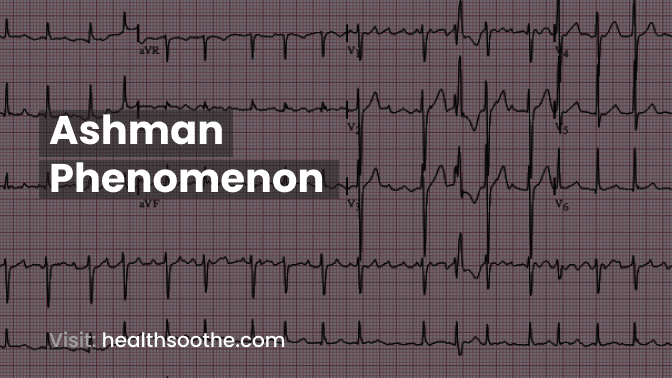The electrical activity of the heart is monitored by an electrocardiogram or ECG. To capture the electric signals, soft electric pads are applied to the patient's hands and feet. An ECG features various gaps in between, known as electrical intervals, which are identified by alphabets that correspond to various cardiac processes. The QRS interval is one such pause or space.
It is the section of an ECG report that is most important. The QRS interval is between 0.06 and 0.10 seconds long. It symbolises ventricular depolarization, which is the term for the sudden rise in heart ventricle pressure.
Two upper chambers, known as the atrium, and two lower chambers, known as the ventricles, make up the four chambers of the heart.
When the ventricles constrict, the process is known as ventricular depolarization, which raises the pressure within the ventricles.
This ventricular depolarization varies when there is a change in the QRS cycle interval, which results in the Ashman phenomenon.
Ashman and Gouaux originally discussed this occurrence in 1947. Understanding this phenomenon is important since it aids in the diagnosis of complicated illnesses that exhibit arrhythmia or irregular heartbeats.
What Causes the Ashman Phenomenon?
A normal heartbeat with an arrhythmia of a lengthy cycle followed by a brief cycle results from a unique shift in ventricular depolarization. The term "Ashman beat" is often used to describe this. Tachycardia, or a fast heartbeat, causes this beat to also be present. The term RR relates to a person's actual heartbeat.
The Ashman phenomenon is the result of an extended RR interval followed by a brief RR interval, which results in an abnormal and deviated QRS complex. The relationship between changes in the refractory time of the cardiac muscles and the accompanying heart rate determines the reason for the Ashman phenomenon.
When a nerve or muscle is not responsive to an instant stimulus, this is referred to as the refractory period. It is also known as an action potential. The reason for the subsequent QRS cycle's deviations is that the mix of long and short RR interval cycles is probably caused by changes in the pulse.
Thus, arrhythmias such as atrial fibrillation are the primary cause of the Ashman phenomenon. One of the causes of the Ashman phenomenon is atrial fibrillation, a kind of arrhythmia that correlates to the alteration in the QRS complex.
What Are the Signs and Symptoms of the Ashman Phenomenon?
The clinical symptoms of the Ashman phenomenon will be seen on a twelve-lead electrocardiogram. Any changes in the QRS interval are detected by reading the baseline rhythm. Because the Ashman phenomenon has no clinical expression, people with this condition do not exhibit any signs or symptoms.
Rarely, patients may have severe palpitations, dizziness, or breathing difficulties as a result of shortness of breath. Although they are not particularly common symptoms, chest discomfort, vertigo, and syncope have all been documented. The Ashman phenomenon is also linked to an abnormally irregular heartbeat.
Along with tachycardia, or a fast pulse, patients may also feel an additional heartbeat or ectopic heartbeat. The physical examination shows an irregular heartbeat. Abnormalities in electrolytes and metabolism may cause atrial fibrillations, which in turn can cause the Ashman phenomenon. The effects of medications may potentially alter the normal heart rate and ultimately the QRS interval.
How Can the Ashman Phenomenon Be Treated?
Since arrhythmia is one of the primary causes of the Ashman phenomenon, a doctor should be knowledgeable about the emergency care of arrhythmia. There is no urgent need for therapy if there are no symptoms, which is the majority of the time. In the event that a heart issue is underlying, it must be treated first.
The Ashman phenomenon often results from or is a side effect of cardiovascular disease that was previously existent, which is the cause. Arrhythmia, tachycardia, or any other clinical symptom that is documented must be treated in order to return the patient's heart rate to normal. Following the initial treatment of various arrhythmias, any underlying cardiovascular illness that may be present is controlled medically.
Since arrhythmia is one of the primary causes of the Ashman phenomenon, a doctor should be knowledgeable about the emergency care of arrhythmia. There is no urgent need for therapy if there are no symptoms, which is the majority of the time. In the event that a heart issue is underlying, it must be treated first.
The Ashman phenomenon often results from or is a side effect of cardiovascular disease that was previously existent, which is the cause. Arrhythmia, tachycardia, or any other clinical symptom that is documented must be treated in order to return the patient's heart rate to normal. Following the initial treatment of various arrhythmias, any underlying cardiovascular illness that may be present is controlled medically.
How to Diagnose the Ashman Phenomenon?
The most often used tool for identifying the Ashman phenomenon is electrocardiography or ECG. For this phenomenon, no particular laboratory studies are required to be performed.
A medical history should be kept in order to account for any ongoing cardiovascular diseases that may be present. Because the heart is sensitive to the effects of several medicines, a complete drug history is also collected.
One technique for identifying the Ashman phenomena is the Fisch criterion. It examines the ECG data, and if a long or short cycle precedes a QRS interval, resulting in an aberrancy in the QRS interval, it proves the existence of the Ashman phenomenon.
Multiple anomalies of the QRS interval on a single ECG fall under the Fisch criteria as well as other criteria. Due to the similarities between the RR and QRS findings of the Ashman phenomena and atrial fibrillation, the Ashman phenomenon may be considered in instances of atrial fibrillation. The irregular heart rate known as atrial fibrillation is brought on by inadequate blood supply to the heart.
Conclusion:
The QRS complex undergoes a physiological change known as the Ashman phenomenon. It happens as a side effect of underlying cardiovascular disorders or as a result of arrhythmia. Although it lacks any obvious symptoms or signs, the Fisch criterion is a crucial diagnostic cornerstone.
When the RR interval, which indicates a person's actual heartbeat, is abnormally long or unusually short, followed by an aberrant QRS complex on an ECG, a diagnosis is established. Electrocardiograms are used to interpret the same, and the signs and symptoms will determine the appropriate course of therapy. The Ashman phenomenon does not have a particularly severe effect on one's quality of life, and it is simple to treat with the knowledge of a reliable diagnosis.



